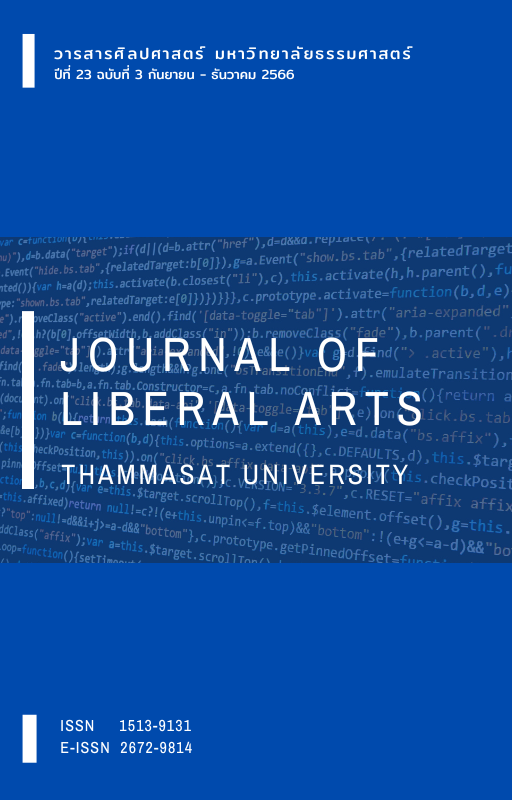Language and Emotions during the Covid-19 Outbreak in Thailand: A Corpus-Based Study
Main Article Content
Abstract
The purpose of this study was to discuss the process involved in the preparation of a Thai emotion corpus based on the information provided in the context of the COVID-19 outbreak between January 2020 and December 2021, with a total word count of 3,341,498. The NECTEC-developed corpus editor program was used to tag the data. Across all forms of COVID-19-related communication in this corpus, there were seven basic emotions. Anger was the most frequent and Surprise was the least frequent. Neutral was only detected in clip data from CCSA. It is argued that authoritative agencies have framed a well-balanced emotion to the Thai public.
Downloads
Article Details

This work is licensed under a Creative Commons Attribution-NonCommercial-NoDerivatives 4.0 International License.
References
จันทิมา อังคพณิชกิจ, สุธาสินี ปิยพสุนทรา, อนุชิต ตู้มณีจินดา, อำนาจ ปักษาสุข, พรทิพย์ เฉิดฉินนภา, และ โกสินทร์ ปัญญาอธิสิน. (2566). ภาษา อารมณ์ความรู้สึก และการสื่อสารสุขภาพของไทยในสถานการณ์การระบาด COVID-19. รายงานวิจัยได้รับทุนสนับสนุนจากกองทุนส่งเสริมวิทยาศาสตร์ วิจัยและนวัตกรรม โดยหน่วยบริหารและจัดการทุนด้านการพัฒนากำลังคน และทุนด้านการพัฒนาสถาบันอุดมศึกษา การวิจัยและการสร้างนวัตกรรม สัญญาเลขที่ B17F640195.
ทัศนีย์ เมฆถาวรวัฒนา. (2553). ความสัมพันธ์ระหว่างภาษา ปริชาน และวัฒนธรรม. วารสารศิลปศาสตร์, 2(2), 151-171.
นววรรณ พันธุเมธา. (2564). คลังคำ. สำนักพิมพ์เครืออมรินทร์.
อมรา ประสิทธิ์รัฐสินธุ์. (2533). ลักษณะสำคัญบางประการในวัฒนธรรมไทยที่แสดงโดยคำเรียกญาติ. ภาษาและวรรณคดีไทย, 7(1), 55-68.
Angkapanichkit, J., Thatsanee, C., Tanyakul, C., & Waranaruechit, S. (2022). An exploration of semantic features for categorizing emotion verbal corpus in Thai. In Thai-Nichi Institute of Technology, 2022 7th International Conference on Business and Industrial Research (ICBIR) (pp. 711-716). http://doi.org/10.1109/ICBIR54589.2022.9786502
Aroonmanakun, W. (2007). Creating the Thai national corpus. MANUSYA: Journal of Humanities, 10(3), 4-17.
Baker, P. (2010). Corpus methods in linguistics. In L. Litosseliti (Ed.), Research methods in linguistics. Continuum.
Baker, P. (2010). Sociolinguistics and corpus linguistics. Edinburgh University Press.
Ekman, P. (1992). An argument for basic emotions. Cognition and Emotion, 6, 169-200.
Ekman, P. (1993). Facial Expression of Emotion. American Psychologist, 48, 384-392.
Expert System & Sociometrica. (2020). Covid-19: Insight and feelings, April 22, 2020: Sadness replaces fear in emotions related to Covid-19. https://www.expert.ai/wp-content/uploads/2020/04/20200422-COVID-19-Insights-Feelings-ENG.pdf
Goddard, C., & Wierzbicka, A. (2014). Words and meanings: Lexical semantics across domains, languages and cultures. Oxford University Press.
Metzler, H., Rimé, B., Pellert, M., Niederkrotenthaler, T., Natale, A. D., & Garcia, D. (2023). Collective emotions during the COVID-19 Outbreak. Emotion, 23(3), 844-858. https://doi.org/10.1037/emo0001111
Renstrom, E. A., & Back, H. (2021). Emotions during the Covid-19 pandemic: Fear, anxiety, and anger as mediators between threats and policy support and political actions. Journal of Applied Social Psychology, 51(8), 861-877.
Semino, E. (2021). “Not soldiers but fire-fighters”–metaphors and COVID-19. Health Communication, 36(1), 50-58.
Schelhorn, I., Schlüter, S., Paintner, K., Shiban, Y., Lugo, R., Meyer, M., & Sütterlin, S. (2022). Emotions and emotion up-regulation during the COVID-19 pandemic in Germany. PlosOne, (7), 2022 https://doi.org/10.1371/journal.pone.0262283
Sutrave, K., Godasu, R., & Liu, J. (2021). Understanding the public sentiment and discourse on COVID-19 vaccine. In The 27th annual Americas Conference on Information Systems (AMCIS) (pp. 1-9). https://aisel.aisnet.org/amcis2021/art_intel_sem_tech_intelligent_systems/art_intel_sem_tech_intelligent_systems/24
Wicke, P., & Bolognesi, M. M. (2020). Framing COVID-19: How we conceptualize and discuss the pandemic on Twitter. PLoS ONE, 15(9), e0240010.
Wilson, A. S, Prescott, J., & Krasniewicz, J. (2016). Using technology for evaluation and support of patients’ emotional states in healthcare. In S. Y. Tettegah & Y. E. Garcia (Eds.), Emotions, Technology, and Health (pp. 3-21). Elsevier.
Wodak, R. (2021). Crisis communication and crisis management during COVID-19. Global Discourse, 11(3), 329–353.

